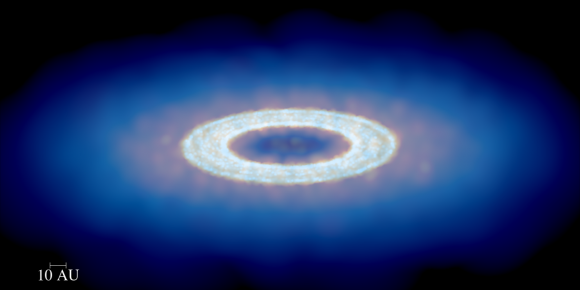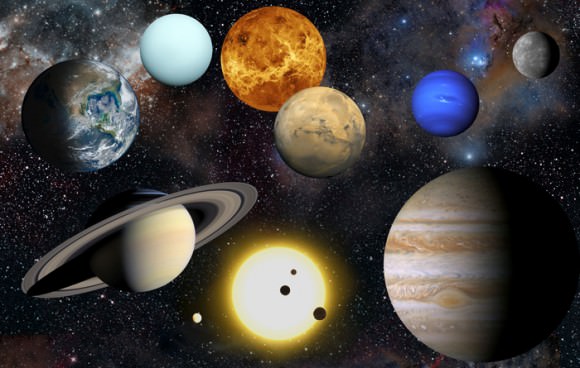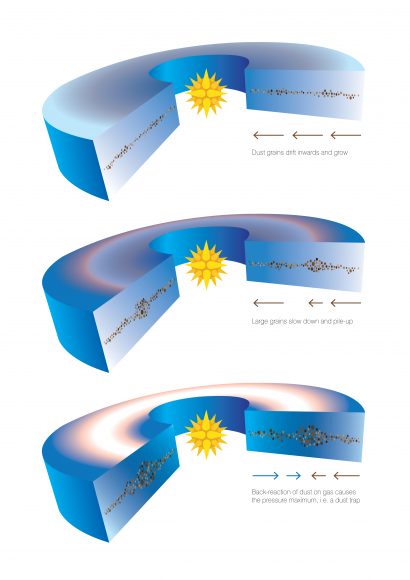The theory of how planets form has been something of an enduring mystery for scientists. While astronomers have a pretty good understanding of where planetary systems comes from – i.e. protoplanetary disks of dust and gas around new stars (aka. “Nebular Theory“) – a complete understanding of how these discs eventually become objects large enough to collapse under their own gravity has remained elusive.
But thanks to a new study by a team of researchers from France, Australia and the UK, it seems that the missing piece of the puzzle may finally have been found. Using a series of simulations, these researchers have shown how “dust traps” – i.e. regions where pebble-sized fragments could collect and stick together – are common enough to allow for the formation of planetesimals.
Their study, titled “Self-Induced Dust Traps: Overcoming Planet Formation Barriers“, appeared recently in the Monthly Notices of the Royal Astronomical Society. Led by Dr. Jean-Francois Gonzalez – of the Lyon Astrophysics Research Center (CRAL) in France – the team examined the troublesome middle-stage of planetary formation that has plagued scientists.

Until recently, the process by which protoplanetary disks of dust and gas aggregate to form peddle-sized objects, and the process by which planetesimals (objects that are one hundred meters or more in diameter) form planetary cores, have been well understood. But the process that bridges these two – where pebbles come together to form planetesimals – has remained unknown.
Part of the problem has been the fact that the Solar System, which has been our only frame of reference for centuries, formed billions of years ago. But thanks to recent discoveries (3453 confirmed exoplanets and counting), astronomers have had lots of opportunities to study other systems that are in various stages of formation. As Dr. Gonzalez explained in a Royal Astronomical Society press release:
“Until now we have struggled to explain how pebbles can come together to form planets, and yet we’ve now discovered huge numbers of planets in orbit around other stars. That set us thinking about how to solve this mystery.”
In the past, astronomers believed that “dust traps” – which are integral to planet formation – could only exist within certain environments. In these high-pressure regions, large grains of dust are slowed down to the point where they are able to come together. These regions are extremely important since they counteract the two main obstacles to planetary formation, which are drag and high-speed collisions.

Drag is caused by the effect gas has on dust grains, which causes them to slow down and eventually drift into the central star (where they are consumed). As for high-speed collisions, this is what causes large pebbles to smash into each other and break apart, thus reversing the aggregation process. Dust traps are therefore needed to ensure that dust grains are slowed down just enough so that they won’t annihilate each other when they collide.
To see just how common these dust traps were, Dr. Gonzalez and his colleagues conducted a series of computer simulations that took into account how dust in a protoplanetary disk could exert drag on the gas component – a process known as “aerodynamic drag back-reaction”. Whereas gas typically has an arresting influence on dust particles, in particularly dusty rings, the opposite can be true.
This effect has been largely ignored by astronomers up until recently, since its generally quite negligible. But as the team noted, it is an important factor in protoplanetary disks, which are known for being incredibly dusty environments. In this scenario, the effect of back-reaction is to slow inward-moving dust grains and push gas outwards where it forms high-pressure regions – i.e. “dust traps”.
Once they accounted for these effects, their simulations showed how planets form in three basic stages. In the first stage, dust grains grow in size and move inwards towards the central star. In the second, the now pebble-sized larger grains accumulate and slow down. In the third and final stage, the gas is pushed outwards by the back-reaction, creating the dust trap regions where it accumulates.

These traps then allow the pebbles to aggregate to form planetesimals, and eventually planet-sized worlds. With this model, astronomers now have a solid idea of how planetary formation goes from dusty disks to planetesimals coming together. In addition to resolving a key question as to how the Solar System came to be, this sort of research could prove vital in the study of exoplanets.
Ground-based and space-based observatories have already noted the presence of dark and bright rings that are forming in protoplanetary disks around distant stars – which are believed to be dust traps. These systems could provide astronomers with a chance to test this new model, as they watch planets slowly come together. As Dr. Gonzalez indicated:
“We were thrilled to discover that, with the right ingredients in place, dust traps can form spontaneously, in a wide range of environments. This is a simple and robust solution to a long standing problem in planet formation.”
Further Reading: Royal Astronomical Society, MNRAS

